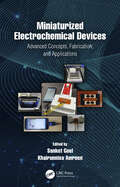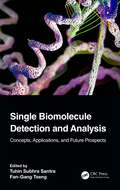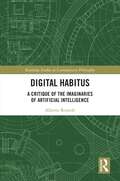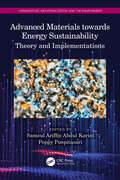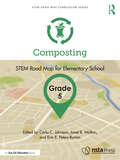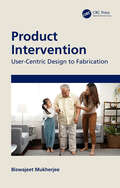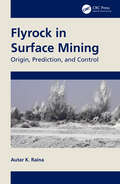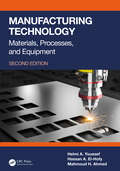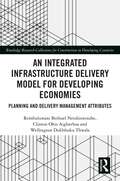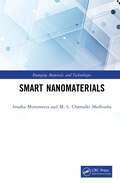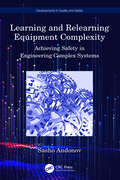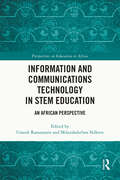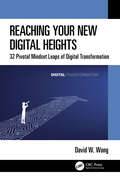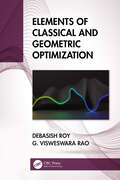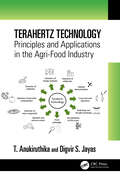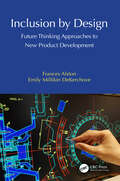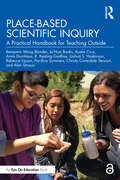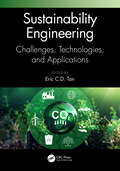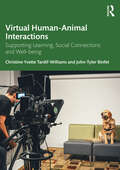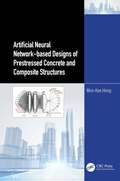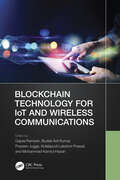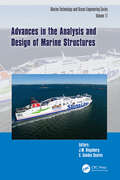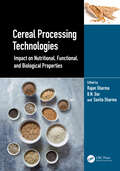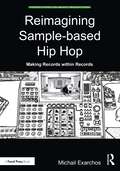- Table View
- List View
Miniaturized Electrochemical Devices: Advanced Concepts, Fabrication, and Applications
by Sanket Goel Khairunnisa AmreenEvidently, electrochemical sensing has revolutionized the electroanalytical detections in the world. Since the 19th century, a huge amount of growth has been visible on various fronts, such as biosensors, energy devices, semiconductor devices, communication, embedded systems, sensors etc. However, the major research gap lies in the fact that most of the reported literatures are bulk systems; hence there are limitations for practical applications. Research in these domains has been carried out by both academia and industry, whereby academics is the backbone whose intellectual outputs have been widely adopted by the industry and implemented for consumers at large. In order to impart portability to the electrochemical sensors for point-of-care application, the collaboration of electrochemistry, microfluidics, electronics and communication as an interdisciplinary forum is crucial. The miniaturization, automation, IoT enabling and integration are the requirements for building the mentioned research gap. The conversion of electrochemical sensing theoretical concepts to practical applications in real time via miniaturization and integration of microfluidics will enhance this domain. In this context, of lately, several research groups have developed miniaturized microdevices as electrochemical-sensing platforms. This has led to a demand of offering a reference book as a guideline for the PhD programs in electrochemistry, MEMS, electronics and communication. Undoubtedly, this will have a huge impact for R&D in industries, public-funded research institutes and academic institutions. The book will provide a single forum to understand the current research trends and future perspectives of various electrochemical sensors and their integration in microfluidic devices, automation and point-of-care testing. For students, the book will become a motivation for them to explore these areas for their career standpoints. For the professionals, the book will become a thought-provoking stage to manoeuvre the next-generation devices/processes for commercialization.
Single Biomolecule Detection and Analysis: Concepts, Applications, and Future Prospects
by Fan-Gang Tseng Tuhin Subhra SantraThis collection discusses various micro/nanodevice design and fabrication for single-biomolecules detection. It will be an ideal reference text for graduate students and professionals in diverse subject areas including materials science, biomedical engineering, chemical engineering, mechanical engineering, and nanoscience. This book- Discusses techniques of single-biomolecule detection, their advantages, limitations, and applications. Covers comprehensively several electrochemical detection techniques. Provides single-molecule separation, sensing, imaging, sequencing, and analysis in detail. Examines different types of cantilever-based biomolecule sensing, and its limitations. Single Biomolecule Detection and Analysis covers single-biomolecule detection and characterization using micro/nanotechnologies and micro/nanofluidic devices, electrical and magnetic detection technologies, microscopy and spectroscopy techniques, single biomolecule optical, and nanopore devices. The text covers key important biosensors-based detection, stochastic optical reconstruction microscopy-based detection, electrochemical detection, metabolic engineering of animal cells, single-molecule intracellular delivery and tracking, terahertz spectroscopy-based detection, total internal reflection fluorescence (TIFR) detection, and Fluorescence Correlation Spectroscopy (FCS) detection. The text will be useful for graduate students and professionals in diverse subject areas including materials science, biomedical engineering, chemical engineering, mechanical engineering, and nanoscience. Discussing chemical process, physical process, separation, sensing, imaging, sequencing, and analysis of single-molecule detection, this text will be useful for graduate students and professionals in diverse subject areas including materials science, biomedical engineering, chemical engineering, mechanical engineering, and nanoscience. It covers microscopy and spectroscopy techniques for single-biomolecule detection, analysis, and their biomedical engineering applications.
Digital Habitus: A Critique of the Imaginaries of Artificial Intelligence (Routledge Studies in Contemporary Philosophy)
by Alberto RomeleThis book proposes a new theoretical framework for approaching the causes and effects that digital technologies and the imaginaries related to them have on the processes of self-interpretation and subjectivation. It formulates three main theses. First, it argues that today’s digital technologies, which are primarily based on artificial intelligence (AI) algorithms and big data are formidable habitus machines: they offer increasingly personalized services, but these machines are actually indifferent to individuals and their personalities. Second, this book contends that the effectiveness of these machines does not depend solely on their concrete capacity to classify the social world. It also depends on the expectations, hopes, fears, and imaginaries that we have concerning these technologies and their capacities. This cultural habitus—a worldview, or world picture—leads us to believe in the concrete effectiveness of AI and its potential for our societies. Third, the author takes this Bourdieusian notion of habitus and connects it to current “empirical turn” in philosophy of technology. He contends that, by looking too closely at the things themselves, many philosophers of technology have deprived themselves of the possibility to study the symbolic conditions of possibility in which single technological artifacts are always embedded. Digital Habitus will appeal to scholars and students working in philosophy of technology, the ethics of artificial intelligence, media studies, and science and technology studies.
Advanced Materials towards Energy Sustainability: Theory and Implementations (Urbanization, Industrialization, and the Environment)
by Samsul Ariffin Abdul Karim Poppy PuspitasariIndustry 4.0 is revolutionizing the way companies manufacture, improve, and distribute their products. It demands the application of renewable energy using advanced materials. Renewable energy is reshaping the fields of industry, agriculture, and households, providing reliable power supplies and fuel diversification. This enhances energy security, lowers the risk of fuel spills, and reduces the need for imported fuels. Examples of material applications used for renewable energy are photovoltaic, solar cells, which can be used in agriculture. This volume has a diverse audience including students, researchers, and academics engaged in materials and renewable energy. Features : Presents latest research on renewable energy in relation to urbanization, industrialization, and the environment. Provides in-depth discussion on modeling and simulation using latest techniques. Provides technical exposure for the readers on advanced materials. Provides numerous examples on properties of biomaterials and their future prospect. Provides up-to-date information on functional materials for industrial application.
Composting, Grade 5: STEM Road Map for Elementary School (STEM Road Map Curriculum Series)
by Carla C. Johnson Erin E. Peters-Burton Janet B. WaltonWhat if you could challenge your fifth-grade students to investigate the role of composting in solid waste management? With this volume in the STEM Road Map Curriculum Series, you can! Composting outlines a journey that will steer your students toward authentic problem solving while grounding them in integrated STEM disciplines. Like the other volumes in the series, this book is designed to meet the growing need to infuse real-world learning into K–12 classrooms. This interdisciplinary, four-lesson module uses project- and problem-based learning to help students use the engineering design process (EDP) to design and create prototypes of compost systems and build a full-scale composting system for school use. Students will synthesize their learning about biotic and abiotic factors, decomposition, and engineering design as they learn about various types of compost systems, create their own portable compost bins, and create materials for a composting publicity campaign at their school. To support this goal, students will do the following: Identify and explain interdependent relationships in ecosystems Compare and contrast several ecosystems Describe how compost systems are designed and constructed and apply this understanding to creating prototypes of various compost systems Understand the concept of scale and apply this understanding to create scaled models of compost systems Apply their understanding of composting, compost systems, and the EDP to create a full-scale compost system for the school Measure various characteristics of compost The STEM Road Map Curriculum Series is anchored in the Next Generation Science Standards, the Common Core State Standards, and the Framework for 21st Century Learning. In-depth and flexible, Composting can be used as a whole unit or in part to meet the needs of districts, schools, and teachers who are charting a course toward an integrated STEM approach.
Composting, Grade 5: STEM Road Map for Elementary School (STEM Road Map Curriculum Series)
by Carla C. Johnson Erin E. Peters-Burton Janet B. WaltonWhat if you could challenge your fifth-grade students to investigate the role of composting in solid waste management? With this volume in the STEM Road Map Curriculum Series, you can! Composting outlines a journey that will steer your students toward authentic problem solving while grounding them in integrated STEM disciplines. Like the other volumes in the series, this book is designed to meet the growing need to infuse real-world learning into K–12 classrooms.This interdisciplinary, four-lesson module uses project- and problem-based learning to help students use the engineering design process (EDP) to design and create prototypes of compost systems and build a full-scale composting system for school use. Students will synthesize their learning about biotic and abiotic factors, decomposition, and engineering design as they learn about various types of compost systems, create their own portable compost bins, and create materials for a composting publicity campaign at their school.To support this goal, students will do the following: Identify and explain interdependent relationships in ecosystems Compare and contrast several ecosystems Describe how compost systems are designed and constructed and apply this understanding to creating prototypes of various compost systems Understand the concept of scale and apply this understanding to create scaled models of compost systems Apply their understanding of composting, compost systems, and the EDP to create a full-scale compost system for the school Measure various characteristics of compost The STEM Road Map Curriculum Series is anchored in the Next Generation Science Standards, the Common Core State Standards, and the Framework for 21st Century Learning. In-depth and flexible, Composting can be used as a whole unit or in part to meet the needs of districts, schools, and teachers who are charting a course toward an integrated STEM approach.
Product Intervention: User-Centric Design to Fabrication
by Biswajeet MukherjeeThis book covers all aspects of design thinking and its intervention as needed for developing products for the elderly. The book deals with the Universal Principles of Design and how they can be included with Technological Interventions for showcasing the product lifecycle. The main technical features include the Anthropometry calculations, Design Thinking approach on the healthcare products, and selection of target group which is elderly in the presented context. Further, the complete product development cycle, the choice of materials, assessment of the designs, prototyping phases and the final product are all discussed in detail. The various fabrication strategies to reduce the cost of the product, ideation stages and Feedback and Assessment right from design to product development stage are discussed. All the Anthropometry details are included specifically for the target group chosen; its mathematical understanding, error, etc. are all discussed in the book. The ideations, rendering and conceptualization based on Cognitive Ergonomics or Hawthorne and various other effects are also discussed in detail.
Flyrock in Surface Mining: Origin, Prediction, and Control
by Autar K. RainaThis book provides a comprehensive understanding of historical and recent research, with a critical review of several aspects of the flyrock phenomenon, along with classification of pertinent literature. This puts flyrock into proper perspective and develops a comprehensive regime for flyrock prediction and control. It also addresses the blast danger zone demarcation based on scientific understanding in comparison to the consequence-based approach supported by pertinent case studies. Features: Discusses exclusive material on flyrock in surface mining. Presents comprehensive and critical review of the flyrock phenomenon. Reviews prediction and control mechanisms in vogue with scientific and risk-based definitions of blast danger zone. Provides new insights into the flyrock definitions, prediction, and prevention along with the research approach to the problem. Includes Indian case studies and summarize global data available in the published domain. This book is aimed at researchers and graduate students in mining and civil engineering, engineering geology, and blasting.
Manufacturing Technology: Materials, Processes, and Equipment
by Helmi A. Youssef Hassan A. El-Hofy Mahmoud H. AhmedThis new edition textbook provides comprehensive knowledge and insight into various aspects of manufacturing technology, processes, materials, tooling, and equipment. Its main objective is to introduce the grand spectrum of manufacturing technology to individuals who will be involved in the design and manufacturing of finished products and to provide them with basic information on manufacturing technologies.Manufacturing Technology: Materials, Processes, and Equipment, Second Edition, is written in a descriptive manner, where the emphasis is on the fundamentals of the process, its capabilities, typical applications, advantages, and limitations. Mathematical modeling and equations are used only when they enhance the basic understanding of the material dealt with. The book is a fundamental textbook that covers all the manufacturing processes, materials, and equipment used to convert the raw materials to a final product. It presents the materials used in manufacturing processes and covers the heat treatment processes, smelting of metals, and other technological processes such as casting, forming, powder metallurgy, joining processes, and surface technology. Manufacturing processes for polymers, ceramics, and composites are also covered.The book also covers surface technology, fundamentals of traditional and nontraditional machining processes, numerical control of machine tools, industrial robots and hexapods, additive manufacturing, and industry 4.0 technologies.The book is written specifically for undergraduates in industrial, manufacturing, mechanical, and materials engineering disciplines of the second to fourth levels to cover complete courses of manufacturing technology taught in engineering colleges and institutions all over the world. It also covers the needs of production and manufacturing engineers and technologists participating in related industries where it is expected to be part of their professional library. Additionally, the book can be used by students in other disciplines concerned with design and manufacturing, such as automotive and aerospace engineering.
An Integrated Infrastructure Delivery Model for Developing Economies: Planning and Delivery Management Attributes (Routledge Research Collections for Construction in Developing Countries)
by Clinton Aigbavboa Wellington Didibhuku Thwala Rembuluwani Bethuel NetshiswinzheThis book explores the attributes of an integrated model for infrastructure delivery as a means to achieve high impact investing, sustainable growth and development in a developing economy. An Integrated Infrastructure Delivery Model for Developing Economies: Planning and Delivery Management Attributes is premised on the understanding that one of the most significant barriers to efficient and effective infrastructure delivery is the nature and extent of fragmentation in the ways in which infrastructure projects are planned, designed, and delivered. Using a Delphi method, the research presented in this book examines the infrastructure delivery models and practices that have been employed in South Africa and other developing countries, and in doing so presents eight attributes for integrated infrastructure delivery. These are: (i) developing a common vision for the community, (ii) stakeholder participation, (iii) integrated project development and scoping, (iv) access to planning information, (v) cross-sectoral planning, (vi) integrated infrastructure master plans, (vii) statutory and regulatory compliance and (viii) integrated contractual frameworks. The book presents a practical model that can serve as a guide and a manual for project planning and development to achieve integrated infrastructure delivery in developing economies. The proposed model should serve as a framework to inform future planning and programming of infrastructure projects within the public sector space. Furthermore, the application of the model will help resolve the problems of fragmentation and lack of coordination in how infrastructure projects are planned and implemented. This book will be beneficial to infrastructure practitioners, policymakers, researchers and academics who pursue best practice models to improve the delivery and management of infrastructure.
Smart Nanomaterials (Emerging Materials and Technologies)
by Imalka Munaweera M. L. MadhushaSmart nanomaterials are the basis of diverse emerging applications, and this book covers their technological advances, innovations, and practical applications. It covers advances in the most critical aspects in chemistry and material fabrication of nanomaterials including engineering/prospective applications. The application of smart nanomaterials in the biomedical field, agriculture, food industry, and apparel industry is covered with practical examples. It discusses the future of smart nanomaterials and the pros and cons associated with smart nanomaterials in a detailed manner. Features: Reviews synthesis methods, characterization techniques, and applications of smart nanomaterials. Explores the significance of using smart nanomaterials in futuristic life including examples. Covers bionsensor sensitivity, selectivity, and stability for long-term operation and nanotechnology technique for possibly detecting hazardous viruses. Provides the manufacturing advantages, energy and electronic advantages, medical benefits, environmental effects, and economic issues. Explains risk assessment on humans in detail. This book is aimed at researchers and graduate students in nanomaterials and materials science.
Learning and Relearning Equipment Complexity: Achieving Safety in Engineering Complex Systems (Developments in Quality and Safety)
by Sasho AndonovWith industrial systems becoming ever more mechanized and reliant on advanced technology, the complexity of equipment, especially in risky industries, is increasing on a daily basis. A thorough understanding of operations and providing safety for these complex systems has become a firm requirement for many. This book offers the knowledge required by safety professionals to provide and maintain the safety of engineering complex systems. Through a scientific and engineering approach to designing, implementing, operating, and maintaining complex systems, Learning and Relearning Equipment Complexity: Achieving Safety in Engineering Complex Systems details the need for more engineering and scientific knowledge to understand and maintain their safety. It gives clear explanations of reasons for a system’s complexity, based on control systems and non-linear dynamics. In addition, the book addresses the necessary changes in the approach and the procedures for the safety assessment of engineering complex systems. The reader will develop a thorough understanding of what complex systems are, why they are complex, and how they are utilized. This book will appeal to any safety professional tasked with complex systems. This extends to professionals in risky industries such as aviation, nuclear power, chemicals, railway and transport, and pharmaceuticals.
Information and Communications Technology in STEM Education: An African Perspective (Perspectives on Education in Africa)
by Umesh Ramnarain Mdutshekelwa NdlovuThis timely book presents the latest scholarly research on the integration of Information Communications Technology (ICT) for enhanced STEM education in African schools and universities. Featuring critical discussion and illustration of key data-led arguments, this volume gives a comprehensive picture of the breadth, complexity, and diversity of issues present in different African countries. It highlights a diverse range of topics such as approaches to ICT integration, the use of digital technologies to support inquiry-based learning, teacher development, and contextual issues in ICT integration for STEM education. Chapters feature contributions and shared experiences from prominent science educators and researchers from across African regions, and demonstrate findings and reflections on emerging trends, pedagogical innovations, and research-informed practices on ICT integration in STEM education. Offering cutting-edge research on STEM and digital education in Africa, the book will appeal to researchers, postgraduate students, and scholars in the fields of STEM education, ICT education, digital education, and pedagogy.
Reaching Your New Digital Heights: 32 Pivotal Mindset Leaps of Digital Transformation
by David W. WangThe 4th Industrial Revolution is here, and it is the catalyst of our mindset changes as we are facing a new world of digital transformation. Mindset stands for our outlook, attitudes, and behaviors toward the world. Now that the world is rapidly changing due to technological advances, our mindset needs to leap with the trend and enable us to excel in the new digital era. Many books may have touched on the subject of digital mindset but this book takes it to a new level. The new Cognitive Model of Digital Transformation, introduced in and followed by this book, is dedicated to digital mindset leaps from key concepts and comparative approaches to best practices. The Cognitive Model of Digital Transformation categorizes the process of digital mindset leaps into five different layers, from Layer 1 as the foundation or starting key concepts, Layer 2 for digital ways of thinking, Layer 3 on digital behaviors and capabilities, Layer 4 on digital transformation, all the way to Layer 5 of wisdomin digital space, walking through the entire journey of digital mindset leaps. This book intends to help get your mindset adapted and ready to navigate digital transformation along the right track. Enjoy this book and its amazing journey of digital mindset leaps.
Elements of Classical and Geometric Optimization
by Debasish Roy G Visweswara RaoThis comprehensive textbook covers both classical and geometric aspects of optimization using methods, deterministic and stochastic, in a single volume and in a language accessible to non-mathematicians. It will help serve as an ideal study material for senior undergraduate and graduate students in the fields of civil, mechanical, aerospace, electrical, electronics, and communication engineering. The book includes: Derivative-based Methods of Optimization. Direct Search Methods of Optimization. Basics of Riemannian Differential Geometry. Geometric Methods of Optimization using Riemannian Langevin Dynamics. Stochastic Analysis on Manifolds and Geometric Optimization Methods. This textbook comprehensively treats both classical and geometric optimization methods, including deterministic and stochastic (Monte Carlo) schemes. It offers an extensive coverage of important topics including derivative-based methods, penalty function methods, method of gradient projection, evolutionary methods, geometric search using Riemannian Langevin dynamics and stochastic dynamics on manifolds. The textbook is accompanied by online resources including MATLAB codes which are uploaded on our website. The textbook is primarily written for senior undergraduate and graduate students in all applied science and engineering disciplines and can be used as a main or supplementary text for courses on classical and geometric optimization.
Terahertz Technology: Principles and Applications in the Agri-Food Industry
by Digvir S. Jayas T. AnukiruthikaTerahertz (THz) technology is an active area of research, but only in recent years has the application of THz waves (T waves) in food and agricultural industries been explored. Terahertz Technology: Principles and Applications in the Agri-Food Industry describes the operating principles of THz technology and discusses applications and advantages of the THz regime of the electromagnetic spectrum for use in the agri-food industry. The agri-food industry is focusing on the development of non-destructive quality evaluation techniques that can provide accurate analysis quickly and are environmentally friendly. Among such techniques is THz technology that provides a novel noninvasive approach to quality assessment and safety assurance of agri-food products. The low energy of T waves is best suited for the analysis of sensitive biomaterials and does not cause photoionization. Therefore, THz imaging is complementary to X-ray imaging. Although accessing the THz spectrum is tedious by conventional devices, the combination of optics and electronics principles has opened a dimension of research in this field. This book provides an overview of THz spectroscopy and imaging, system components, types of THz systems, and applications and advantages of THz for applications in the agri-food industry. It describes the basic working mechanism, operating principle, operation modes, and system components of THz spectroscopy and imaging. Various advancements in THz technology related to agricultural and food applications are discussed that could serve as a guidebook for all those working and interested in non-destructive food assessment techniques. Key Features: Explores broader applications of the THz regime in the agri-food sector Describes system components, different forms of THz systems, and the working principle of T waves for spectroscopic and imaging techniques Provides insights on future research needs for industrial implementation of THz technology Complements the knowledge of other existing non-destructive spectroscopy and imaging techniques for food analysis Although books on biomedical applications of THz have been published, no book is available that deals with applications in the agri-food industry. Hence, Terahertz Technology is beneficial for undergraduate and graduate students and those food industry professionals involved in research related to non-destructive quality assessment and imaging techniques.
Inclusion by Design: Future Thinking Approaches to New Product Development
by Frances Alston Emily Millikin DeKerchoveThis book introduces a new speculative design process for inclusive new product development (NPD). The authors offer Vision Enabled Design Thinking (VEDT), a human-centered technological design framework incorporating the use of Design Lens and Vision Concepting, as a way for the designer to ideate and reflect on product development concepts within a deeper sociocultural context. The authors incorporate project management concepts into the overall design process through the development of a new design process, "4-D Algorithm for New Product Development".Inclusion by Design: Future Thinking Approaches to New Product Development formalizes the use of speculative design as a means for more inclusive NPD and promotes management of the design process as a needed skill for future engineers and designers. It provides a novel design methodology of VEDT for engaging vision concepting, through the use of Design Lenses in engaging speculative design practices and offers an implementation framework to support the sustainable adoption and use of future design methods. The 4-D Algorithm for New Product Development promotes inclusivity in design while addressing practical aspects of managing the design process in today’s corporate business environment.Those involved with interactive product and technology design, new product development, design researchers and managers, engineers, as well as professionals and graduate students will find this book useful.
Place-Based Scientific Inquiry: A Practical Handbook for Teaching Outside
by Benjamin Wong Blonder Ja'Nya Banks Austin Cruz Anna Dornhaus R. Keating Godfrey Joshua S. Hoskinson Rebecca Lipson Pacifica Sommers Christy Stewart Alan StraussLearn how to facilitate scientific inquiry projects by getting out of the classroom and connecting to the natural environment—in your schoolyard, or in your community! Providing a contemporary perspective on how to do scientific inquiry in ways that can make teachers’ lives easier and students’ experiences better, this book draws on authentic inquiry, engaging with communities, and teaching through project-based learning to help students design and carry out scientific inquiry projects that are grounded in their local places. This accessible guide will help you to develop skills around facilitation, team building, and learning outdoors in schoolyards and parks, acting as a go-to toolkit for teachers to help build confidence and skills in these areas. Written according to the Next Generation Science Standards, this book supports teachers in fostering community engagement and a justice-first classroom. The approachable resources included in this book will help teachers with all levels of experience succeed in empowering students grades 3–12 in their science learning. Additional support materials including template documents for student use and for teacher planning, as well as examples of real student work, are available online. The Open Access version of this book, available at www.taylorfrancis.com, has been made available under a Creative Commons Attribution (CC-BY) 4.0 license
Sustainability Engineering: Challenges, Technologies, and Applications
by Tan, Eric C.D.Sustainability Engineering: Challenges, Technologies, and Applications focuses on emerging topics within sustainability science and engineering, including the circular economy, advanced recycling technologies, decarbonization, renewable energy, and waste valorization. Readers will learn the trends driving today’s sustainability research and innovation as well as the latest in sustainable process technologies. This book: Addresses emerging sustainability development challenges, progress, and disruptive technologies Discusses biological sustainability, recycling technologies, and sustainable process design and manufacture Features a comprehensive view from renowned experts who are leaders in their respective research areas This work is aimed at an interdisciplinary audience of engineers and scientists working on solutions to advance the development and application of sustainable technologies, including – but not limited to – chemical and environmental engineers.
Virtual Human-Animal Interactions: Supporting Learning, Social Connections and Well-being
by John-Tyler Binfet Christine Yvette Tardif-WilliamsInterest in the field of human-animal interactions is burgeoning, and researchers and educators are keen to understand the science undergirding research that helps us understand interactions between people and animals. Recently, exciting and innovative research is focusing on how people’s virtual interactions with animals can enhance their learning, social interactions, and well-being. This research aims to answer questions such as, "What types of interactions do people have with animals in a virtual context? How do people access and experience their virtual interactions with animals? Do virtual interactions with animals hold potential to enhance people’s well-being and learning in the same way that in-person interactions with animals have been documented? What educational strategies could be employed to enhance people’s virtual interactions with animals? How can we respect animals as research participants within a virtual context?" Drawing from seminal and cutting-edge research in the field of human-animal interactions, these questions and others are answered in Virtual Human-Animal Interactions. Research-informed and grounded in critical discussions of theory and practice, this book challenges readers to reconceptualize their understanding of research and practice exploring the complexities inherent in, and arising from, people’s virtual interactions with animals. Further, with an eye to the future, this book illuminates readers’ thinking around the empirical and practical implications of facilitating interactions between people and animals within virtual contexts. Researchers and educators from across disciplines will find Virtual Human-Animal Interactions both scientifically savvy and practical.
Artificial Neural Network-based Designs of Prestressed Concrete and Composite Structures
by Won‐Kee HongThis book introduces artificial neural network (ANN)-based Lagrange optimization techniques for a structural design of prestressed concrete structures based on Eurocode 2, and composite structures based on American Institute of Steel Construction and American Concrete Institute standards. The book provides robust design charts for prestressed concrete structures, which are challenging to achieve using conventional design methods.Using ANN-based design charts, the holistic design of a post-tensioned beam is performed to optimize design targets (objective functions), while calculating 21 forward outputs, in arbitrary sequences, from 21 forward inputs. Applies the powerful tools of ANN to the optimization of prestressed concrete structures and composite structures including columns and beams Multi-objective optimizations (MOO) of prestressed concrete beams are performed using an ANN-based Lagrange algorithm Offers a Pareto frontier using an ANN-based MOO for composite beams and composite columns sustaining multi-biaxial loads Heavily illustrated in color and with diverse practical design examples in line with EC2, ACI, and ASTM codes The book offers optimal solutions for structural designers and researchers, enabling readers to construct design charts to minimize their own design targets under various design requirements based on any design code.
Blockchain Technology for IoT and Wireless Communications
by Budati Anil Kumar Gajula Ramesh Praveen Jugge Kolalapudi Lakshmi Prasad Mohammad Kamrul HasanSmart communications are the concept in which smart appliances and devices are integrated into an application that runs in a smart hand-held device. The residents of a smart home can have complete control over their home’s electronic gadgets using wireless communications. These technologies can help people control gadgets in the home/office remotely and often simultaneously, which increases convenience and reduces time spent on these tasks. However, problems can arise in the security systems associated with these smart devices; security may be compromised when there are loopholes or human mistakes. When security credentials are lost, overall security can also be lost. This is because smart technology is made up of plenty of devices that are integrated with Internet of Things (IoT) technology and the cloud. This environment can introduce many security issues, as discussed in this text. Blockchain is a promising technology that operates in a decentralized environment to protect devices and the data collected by devices from security and privacy issues by using wireless communication technology. Blockchain-enabled IoT can be used to achieve end-to-end security. Blockchain technology is already used in wireless sensor/communication networks to estimate and predict house data and civil structures. IoT-integrated innovative applications like smart homes present unique security and privacy challenges. Scalability is the main problem as the current centralized IoT platforms have message routing mechanisms that create a bottleneck in scaling up too many devices used in IoT. As many devices are participating in generating data, such a setup may also be subjected to Distributed Denial of Service (DDoS) attacks. Lack of data standards is another cause of concern as it leads to interoperability problems. Blockchain technology for IoT and wireless communications offers a promising solution for smart devices. These technologies can provide end-to-end security and overcome the aforementioned problems. The usage of open-standard distributed IoT solutions can solve many problems that are associated with centralized approaches. Blockchain technology is nothing but a distributed ledger of transactions. It offers direct communication to connected devices. Such devices collect data, and all legitimate participants can access said data. Thus, decentralized blockchain networks can provide improved security for IoT-based solutions.
Advances in the Analysis and Design of Marine Structures: Proceedings of the 9th International Conference on Marine Structures (MARSTRUCT 2023, Gothenburg, Sweden, 3-5 April 2023) (Proceedings in Marine Technology and Ocean Engineering)
by J. W. RingsbergAdvances in the Analysis and Design of Marine Structures is a collection of papers presented at MARSTRUCT 2023, the 9th International Conference on Marine Structures, held in Gothenburg, Sweden, 3-5 April 2023. The conference was organised by the Division of Marine Technology, Department of Mechanics and Maritime Sciences at Chalmers University of Technology, in Gothenburg, Sweden. The MARSTRUCT Conference series deals with Ship and Offshore Structures, addressing topics in the fields of: • Methods and tools for loads and load effects• Methods and tools for strength assessment• Experimental analysis of structures• Materials and fabrication of structures• Methods and tools for structural design and optimization• Structural reliability, safety, and environmental protection The MARSTRUCT conferences series of started in Glasgow, UK in 2007, the second event of the series took place in Lisbon, Portugal in March 2009, the third in Hamburg, Germany in March 2011, the fourth in Espoo, Finland in March 2013, the fifth in Southampton, UK in March 2015, the sixth in Lisbon, Portugal in May 2017, the seventh in Dubrovnik, Croatia in May 2019, and the eighth event in Trondheim, Norway in June 2021. Advances in the Analysis and Design of Marine Structures is essential reading for academics, engineers and all professionals involved in the design of marine and offshore structures. The Proceedings in Marine Technology and Ocean Engineering series is devoted to the publication of proceedings of peer-reviewed international conferences dealing with various aspects of ‘Marine Technology and Ocean Engineering’. The Series includes the proceedings of the following conferences: the International Maritime Association of the Mediterranean (IMAM) Conferences, the Marine Structures (MARSTRUCT) Conferences, the Renewable Energies Offshore (RENEW) Conferences and the Maritime Technology (MARTECH) Conferences. The ‘Marine Technology and Ocean Engineering’ series is also open to new conferences that cover topics on the sustainable exploration and exploitation of marine resources in various fields, such as maritime transport and ports, usage of the ocean including coastal areas, nautical activities, the exploration and exploitation of mineral resources, the protection of the marine environment and its resources, and risk analysis, safety and reliability. The aim of the series is to stimulate advanced education and training through the wide dissemination of the results of scientific research.
Cereal Processing Technologies: Impact on Nutritional, Functional, and Biological Properties
by Rajan Sharma Savita Sharma B. N. DarCereals are the principal dietary components of human diet and have been for several thousand years. Whole grain cereals are not only an excellent source of energy, but also enrich the diet. The processing of cereals prior to consumption is a necessary step in production chain to make them palatable and enhance bio- and techno-functional performance. Cereal Processing Technologies: Impact on Nutritional, Functional, and Biological Properties reviews cereal processing technologies and their impact on quality attributes of cereals, detailing the processing techniques of cereals with recent advancements followed by their impact on nutritive, functional and biological potential. Each chapter covers three major components as a) technological details for the processing treatment, b) impact on nutritive, functional and biological properties and c) characterization of processed products. Key Features: Focuses on different cereals for nutritive and functional characteristics Explores mechanical, biological, thermal and non-thermal processing treatments of cereals Presents impact of different treatments on biological and techno-functional properties of cereals Discusses characteristics of the processed products The contents of Cereal Processing Technologies are an asset for researchers, students and professionals, and can be potentially used as a reference and important resource for academia and future investigations. This book helps readers identify how different techniques for processing cereal grains enhance the targeted nutritional and functional quality.
Reimagining Sample-based Hip Hop: Making Records within Records (Perspectives on Music Production)
by Michail ExarchosReimagining Sample-based Hip Hop: Making Records within Records presents the poetics of hip-hop record production and the significance of sample material in record making, providing analysis of key releases in hip-hop discography and interviews with experts from the world of Hip Hop and beyond. Beginning with the history of hip-hop music making, this book guides the reader through the alternative techniques deployed by beat-makers to avoid the use of copyrighted samples and concludes with a consideration of the future of Hip Hop, alongside a companion album that has been created using findings from this research. Challenging previous theoretical understandings about Hip Hop, the author focuses on deconstructing sonic phenomena using his hands-on engineering expertise and in-depth musicological knowledge about record production. With a significant emphasis on both practice and theory, Reimagining Sample-based Hip Hop will be of interest to advanced undergraduates, postgraduates, and researchers working in audio engineering, music production, hip-hop studies, and musicology.
